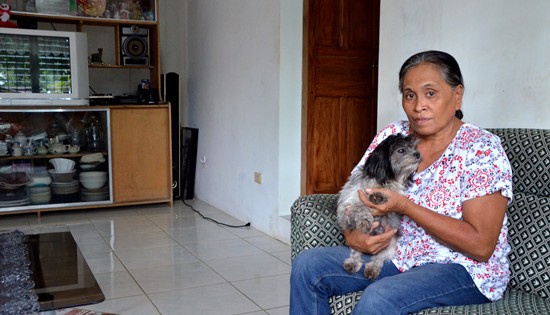
The
house the Nerios built through the years.
(Jose Alsmith L.
Soria) |
The widow
By
JOHN COLASITO
May 23, 2019
TACLOBAN CITY –
Aquilina Bronio was in her second year college taking up Civil
Engineering course when she married Bonifacio Nerio, a high school
classmate and neighbor in Barangay Tejero in Hilongos, Leyte. Both
came from farming families.
To survive, they worked as
rice tenants in three landholdings in their village with a combined
area of four hectares owned by three different landowners. Through
the intervention of the Department of Agrarian Reform (DAR), the
couple entered leasehold agreements with the said landowners,
thereby increasing their share.
“It was advantageous to
us,” Aquilina said. “Especially when we were already starting to
have children,” she added. Aquilina remembers the difficulty of
making both ends meet.
The couple averages 350
cavans of rice during harvest time. “52 cavans go to the three
landowners as rentals (for the four hectares ricefields)”, Aquilina
shared.
But, she explained, “the
remaining harvests left to us were not enough to meet our growing
needs”. According to her, “we had to find other ways to increase our
income”.
So, they raised ducks in
the 1980s. They let the ducks produce eggs which they sold for
additional income. They also made “balut”. The full-grown duck, the
eggs, and the balut, all these they sold not only in Hilongos, but
they went to other towns, even as far as the eastern side of Leyte
province just to make profit.
In 2010, Aquilina
considered themselves lucky for her husband was included among the
recipients of certificates of land ownership award (CLOAs) issued by
DAR. She added, their CLOA covered a .25 hectare cocoland previously
owned by the Vega family. “We were so happy because we can proudly
say, this land is ours,” Aquilina reminisced.
It was a big help to us,
said Aquilina, for they need not give share to anybody. “The profit
was all ours,” she added.
Meanwhile, for the
ricefields, Aquilina further disclosed, the problem they always
encountered was in renting farm equipment. According to her, they
always had to compete with other farmers in renting tractor during
land preparation, and thresher during harvest time which was on a
first come, first serve basis. Most of the time, we are accommodated
last by the owner of the machines, Aquilina said.
“So, we borrowed money to
buy a hand tractor first,” she narrated. It costed P105,000.
According to her, “we paid our lender during harvest. When we
fully-paid our lender, we renewed our loan to purchase two
threshers, amounting to P46,000 per unit, on separate occasions. We
had to impose financial discipline.”
Having acquired these
machines helped us make work faster and freed us from equipment
rentals, she quipped. Instead, we earned additional income by
offering the tractor and the threshers for rent, Aquilina added.
They earn P150 per hour
from tractor rental, while they get five cavans of rice for every
100 cavans of threshed rice for the use of their threshers.
According to Aquilina, they earn an average net income of P30,000
from thresher rental alone every harvest season when the cavans of
rice paid to them are sold.
From then on, life for
them became lighter and blissful. They got rid from loans, and
started to save part of their income.
With hard work,
perseverance and discipline, the couple was able to construct slowly
through the years a concrete house, far from their previous house
that was made only of light materials. They were also able to send
their four children to school. Three of them are now employed.
But as the song of Barbara
Streisand goes, “some good things never last,” Bonifacio suffered
cardiac arrest in 2014, leaving Aquilina a widow.
Everything left by her
husband, were products of the couple’s hard work and collaboration.
“As his wife,” Aquilina said, “I need to help my husband for us to
survive life’s challenges”.
Aside from continuing what
she and her husband had established throughout their married life,
Aquilina, now 62 years old, is active as the secretary of the Tejero
Riceland Cultivators Association since 2015.
She is accompanied at home
by her third child Criselda Grace who is employed at the Municipal
Agriculturist’s Office in their town.
Not all recipients of the
government’s agrarian reform program in their area had reached what
the couple had achieved. To Aquilina, it was because she and her
husband had no vices, and that they value every single cent they
earned. Their story was a testament of love and hard work.
|
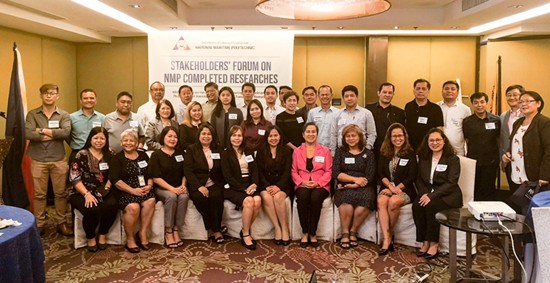
Participants
of the NMP Stakeholders’ Forum on NMP 2018 Completed
Researches on 28 March 2019 at The Bayleaf, Intramuros. |
NMP shares 2018
completed researches to stakeholders
By
National Maritime
Polytechnic
April 4, 2019
TACLOBAN CITY –
True to its commitment of improving the welfare and development of
the Filipino seafarers through the conduct of maritime researches,
the National Maritime Polytechnic (NMP) conducted a Stakeholders’
Forum on 28 March 2019 at The Bayleaf Intramuros, Manila.
The activity was organized
by NMP’s Maritime Research and Development Division (MRDD) aimed to
disseminate its researches as well as provide a venue for discussion
on results particularly those having policy implications, – three
(3) researches were presented, namely:
Harbor Pilotage in the Philippines: A Review of Interventions in
Licensing, Appointment and Capability Building of Harbor Pilots
The study aims to review
the interventions that have been established by the government and
other stakeholders in maintaining robust and effective pilotage
services in the country.
Specifically, the
objectives of the study are: 1) Examine the policy and regulatory
framework on harbor pilotage in the Philippines, in general, and on
licensing, appointment, and capability building, in particular. 2)
Analyze implementation gaps of these policies and regulations. 3)
Identify policy and program recommendations to enhance the harbor
pilotage services in the Philippines.
Findings of the study will
provide valuable inputs in the review and enhancement of policies
and practices governing pilotage in the different pilotage districts
in the country, particularly in the licensing, appointment and
capability building of the country’s harbor pilots, and on other
vital concerns raised by stakeholder-respondents. Improved and
harmonized policies and regulations issued by regulatory bodies,
which are complied by concerned stakeholders will lead to robust and
efficient harbor pilotage services towards an efficient maritime
transport system in the country.
Required Non-Technical (Soft Skills) by Employers for Shipboard
Employment of Management Level Officers (MLOs)
The study seeks to examine
the required training programs that are beyond the requirements of
the Standards of Training Certification and Watchkeeping (STCW), as
amended, focusing on the non-technical skills of MLOs that are
assessed and required by the employers.
Specifically, the
objectives of the study are: 1) Determine the non-technical skills
of the management level deck and engine officers for their rank and
position onboard vessels, as required by employers. 2) Determine the
interventions implemented by employers to enhance the non-technical
skills of the MLOs, 3) Determine the availability of the identified
training programs for the non-technical skills requirements of MLOs.
Findings of the study will
provide significant inputs in providing interventions that will
equip the Filipino seafarers with value-added skills on top of the
technical skills required under the 1978 STCW, as amended, to make
them the ‘choice’ seafarers in the international maritime labor
market.
Philippine Maritime Manpower Factbook 2018
This is an initiative to
gather and present in one comprehensive report data and statistics
in the Philippine maritime industry to make these readily available
and accessible to industry stakeholders.
Primarily, it aims to
provide a picture of the Philippine maritime manpower sector,
presented in graphs and figures that are derived from existing data
from various source agencies, published reports and research
findings. Other significant country data are provided to give a
holistic snapshot of the Philippines as a maritime nation.
This research project will
provide a valuable tool to industry stakeholders, affording them
valuable data and statistics on the country’s profile as a maritime
nation readily accessible for decision-making in policy and program
development.
Findings of the researches
were disseminated to the industry stakeholders from the government,
maritime education and training (MET) institutions, maritime
associations, seafarers’ organizations, shipping companies and
manning agencies. Recommendations from the researches may serve as
valuable inputs to policy making and program development that impact
on the Filipino seafarers as a special workforce of the country.
In his welcome message,
NMP Executive Director, Joel B. Maglunsod highlighted the
significance of the activity.
“Sa mga nagdaang taon
marami nang nagawang training programs ang NMP na resulta ng mga
rekomendasyon ng mga natapos na researches. The researches were also
used by the government administration and regulatory agencies in the
formulation of policies, standards and also in the preparation of
plans and programs, development of training programs na lahat ay
para sa ikabubuti ng ating mga marino, at matulungan sila sa
pagkumpleto sa mga requirements na hinahanap sa kanila para
makasakay sa barko.” he said.
Nothing but good words and
appreciation were uttered by Undersecretary for Employment, Migrant
Workers Welfare, Financial and Administrative Services Cluster,
RenatoL. Ebarle during his inspirational message.
“I would like to commend
the National Maritime Polytechnic for organizing this event annually
and putting us all here together. Your support to the Agency means
you support our country’s seafarers and our maritime industry”, said
Usec. Ebarle.
He also emphasized the
need to enhance the knowledge, skills and abilities of the Filipino
seafarers to maintain their competitiveness and strengthen the
country’s maritime community.
“We need to upgrade them
in order to increase our market share in the officers’ category,
especially the management level officers, and to maintain their
status as “seafarer of choice”, he disclosed.
The forum also served as a
venue for the Agency to present the NMP Research Agenda 2019-2021
containing proposed research topics based on the identified priority
areas in line with the strategic directions of the Agency. NMP
believes that the stakeholders should be involved in the development
of the research agenda as well as in the implementation of
researches through collaborative efforts to ensure responsiveness of
the NMP’s research undertakings to the current and emerging needs of
the maritime industry.
Moreover, a plaque of
appreciation was given to the cooperating agencies who extended
invaluable support in the conduct of NMP researches / studies in
2018 particularly the Commission on Higher Education (CHED),
International Mariners Management Association of Japan and
Philippine-Japan Manning Consultative Council Inc. (IMMAJ-PJMCC),
Maritime Industry Authority (MARINA), Philippine Coast Guard (PCG),
Philippine Overseas Employment Administration (POEA), and Philippine
Ports Authority (PPA).
The conduct of research is
one of the mandates of NMP, in which research outputs are utilized
to formulate policies and regulations for the improvement of the
maritime manpower sector of the industry. NMP is also tasked to
conduct researches on the latest maritime technology.
The forum was attended by
thirty-six (36) participants. Out of the said number only
twenty-five (25) were able to answer the post-forum evaluation form.
Based on the evaluation
instrument gathered, 100% (25 out of 25) rated the research reports
and conduct of forum satisfactory to excellent.
Aside from its research
function, the NMP continues to upgrade its facilities and provide
maritime trainings required pursuant to the Standards of Training,
Certification, and Watch keeping for Seafarers (STCW) Convention as
amended in 2010 including value-adding courses towards improving the
qualifications of Filipino seafarers for their employment
acceptability and enhanced competitiveness.
Those interested in NMP
research undertakings may visit the NMP website (www.nmp.gov.ph) and
access the e-Research Information System Portal which is designed to
disseminate NMP completed researches, present the Research Agenda
and engage the industry stakeholders to collaborate in the research
activities.
For more information about
NMP trainings viewers may visit the agency’s facebook page (www.facebook.com/nmptrainingcenter)
where all related information on NMP trainings are available.
Further, NMP encourages
seafarers to avail of the NMP-OWWA (Overseas Workers Welfare
Administration) Seafarers’ Upgrading Program (SUP) which entitles
the beneficiary to receive financial assistance for training costs
from the OWWA.
PBSP, DepEd
launch Year 2 of educational assistance to Olango SHS scholars
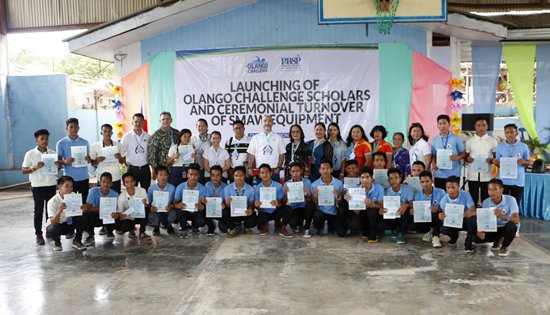
By
PBSP
December 5, 2018
CEBU CITY – As the
youngest of seven children, 18-year-old April Mae Siton wanted to
finish her senior high school (SHS) education without relying too
much on her aging parents.
For years, her father, a
fisherman, and her mother who works as a shell accessories worker,
have been trying to make ends meet so her siblings can finish their
studies and have a better life. To help lessen the cost of her
studies, she took up a Senior High School (SHS) strand that had the
least expenses, Food and Beverage Services (FBS). She also worked
part-time jobs to be able to help her parents pay for school
expenses.
“My original dream was to
become a police officer or a seaman. But I no longer wanted to
burden to my parents and siblings for my expenses even if they
wanted to support me. My parents are already old and my older
siblings have their own families already so I do not want to depend
too much on them, especially with my plan to pursue college. FBS was
the most ideal choice,” Siton added.
Luckily, Siton’s plans
were answered when she was selected as one of the scholars of a
one-year scholarship assistance from PBSP and corporate sponsors
through the Olango Challenge, an open-water swimming event held
every May that raises funds for education programs on Olango island.
PBSP, Olango Challenge
corporate donors, and DepEd officially launched a one-year
educational assistance project that will support 100 junior and
senior high school scholars of Sta. Rosa National High School. The
event also witnessed the ceremonial turnover of laboratory equipment
for the Shielded Metal Arc Welding (SMAW) course in the school.
“This is a dream come true
for me to become a scholar because I really tried my best to be
chosen. Now, I can fulfill my future dreams because of this
financial assistance without burdening my parents,” Siton added.
Aid for a Hundred Students
Sta. Rosa NHS is one of
the three senior high schools located within the island. Most of its
students face financial difficulties that prevent them from
continuing their SHS education, especially that Technical-Vocational
Livelihood track (TVL) mostly requires students to purchase
materials for their school projects. The school’s effective
implementation of its TVL curriculum is also hampered by the
shortage of facilities and equipment.
“We chose to continue our
assistance to Sta. Rosa NHS because it focuses on providing
Technical Vocational Livelihood (TVL). If we want our students to
gain holistic understanding and appreciation in their chosen
strands, its shortages need to be addressed. We also want the
students to learn skills that match most of the industry
requirements in Mactan and the rest of Cebu,” PBSP trustee and
Visayas Executive Committee Chairman Jose Antonio Aboitiz said.
The scholarship assistance
includes the monthly transportation and project allowances,
registration fees for National Certification assessments, and
employment assistance for students wanting to find jobs after
graduation. The provision of tools and equipment for the SMAW
laboratory, on the other hand, aims to contribute to the improved
curriculum delivery of the school and strengthen the students’
competencies. Tools and equipment include coveralls and uniforms,
leather gloves, respiratory masks, welding rods and shields, work
suits and gloves, angle grinders, and cutting and grinding disks.
“Some of you will choose
to work immediately after you graduate. Some of you will go on to
further studies. We hope that the assistance that we provide you
helps to lighten your load and lets you concentrate on the skills
that you are learning and the education that you are getting from
the school,” Aboitiz added.
Present during the program
launch were Oriental Port and Allied Services Corporation (OPASCOR)
Chairman and Chief Executive Officer Tomas Riveral, GMR Megawide
Cebu Airport Corporation (GMCAC) Junior Manager for Corporate
Communications and CSR Avigael Maningo, and Aboitiz who distributed
certificates and allowance vouchers to the scholars.
Building Schools through
the Olango Challenge
This is the 11th year that
PBSP has continuously poured in support for Olango island schools
through the Olango Challenge. Since the event’s launch in 2008, it
has built nine classrooms for Olango’s elementary schools and
provided educational assistance to 190 SHS students.
This is the second year
that PBSP provided educational assistance to the SHS students
through the Olango Challenge proceeds. Major sponsors for this
year’s Olango Challenge include the Aboitiz & Company, Dow Chemicals
Philippines, Inc., GMCAC, Ramon Aboitiz Foundation, Inc., and
OPASCOR.
“We hope that by providing
them with these interventions, the students will successfully pass
their subjects, perform well, and access better job opportunities
after graduating from senior high school,” Aboitiz added.
Feature Story:
Wife fulfills
soldier’s dream
|
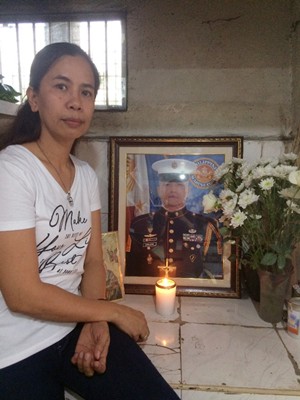
FULFILLING
THE PROMISE. Leah Dinglasan, 41, fulfills the dream and her
promise to husband Marine Technical Sergeant Aldrin Cadiz
Dinglasan to grow the business the soldier has started. |
By
DTI-ROG-SB Corp
October 19, 2018
LIPA, Batangas –
Leah Dinglasan stares blankly in the distance, wondering what
happened to her husband, Marine Technical Sergeant Aldrin Cadiz
Dinglasan, and if he is ever coming back.
This has been her routine
ever since she lost her husband during the five-month siege in
Marawi City after an ISIS-affiliated group from Mindanao took over
the city.
While Leah keeps herself
busy in managing the business her husband has left her, the widow is
still coping with her loss.
“Mahirap, siyempre iniisip
ko parin siya. Pero tuloy lang ang buhay,” Leah said, adding that
she was left to care for their three children.
Tech. Sgt. Dinglasan, 41,
was already three days into the siege after a sniper bullet struck
his cheek on May 31, 2018. Moments before his death, he called Leah
that once he returns from his tour of duty, they would manage
together the small sari-sari store business they had started.
The soldier was set to
retire after his Marawi duty.
After receiving a call and
hearing the news of the soldier’s demise from his commander, Leah
was at first in disbelief. She argued that he just called moments
before.
Leah narrated how Tech.
Sgt. Dinglasan’s body can’t be recovered due to heavy firing from
enemy snipers. His body was recovered three days after his death.
Sari-sari store
Back in March 2017, the
couple started a small variety store business for their family’s
upkeep and finance their children’s studies.
With P20,000 in hand,
Tech. Sgt. Dinglasan bankrolled the variety store and started the
business before leaving for his tour of duty.
Leah was left to manage
the business, while her husband is in Marawi City.
The couple hoped that
soon, once he retires, they would grow the business into a
mini-grocery store.
Government assistance
After her husband’s death,
Leah received assistance from the government in various forms and
from the private sector.
Leah in March 2018
received a P100,000 loan assistance from the Small Business
Corporation (SB Corp.) under its special program, Wounded-and-Killed
in Action (WIA-KIA), an offshoot program to help soldiers and police
who were either killed or wounded during the Marawi conflict, from
the Pondo sa Pagbabago at Pag-asenso (P3) micro loan program.
“Mayroon ding pension from
the Armed Forces of the Philippines, Philippine Veterans Affairs
Office, Employees Compensation Commission, financial and educational
assistance para sa mga anak namin, at mayroon din galing sa private
sector,” Leah added.
With the livelihood
assistance she received, Leah made a few changes in the store,
enlarging it and adding more supplies.
Five months after she
received the financial assistance, the store is now worth P150,000,
a 50% increase in capital.
On casual days, Leah could
earn P8,000 while the minimum she could earn is P3,000 on Mondays.
“Minsan kumikita ako ng
P8,000, yun na ang pinakamalaki. Pero kapag Monday, kumikita lang
ako ng P3,000,” she offered.
Leah explained that it was
Tech. Sgt. Dinglasan’s dream for the business to grow.
“Ang sabi niya sakin “Ma,
gusto ko yung tindahan natin magsimula sa maliit. Gusto ko
palalakihin natin. Hindi yung tulad noong dati na kaunti lang yung
laman ng tindahan natin,”” she said, holding back tears.
She also hopes that after
she completes the payment for the P100,000 loan from SB Corp., she
can borrow money from the P3 program to expand her business.
While she understands that
her husband is gone, Leah is still grateful to Tech. Sgt. Dinglasan
that despite knowing that she won’t share the accomplishment with
him, he had left her and their children something that they will
treasure.
“Gusto kong magpasalamat
sa nasa ‘Itaas’ at sa asawa ko, dahil hindi niya kami pinabayaan,”
Leah said.
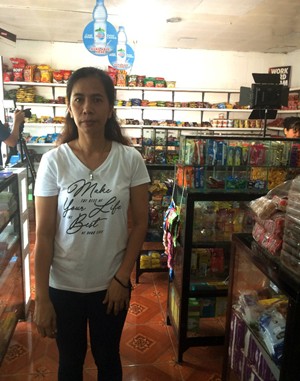
|
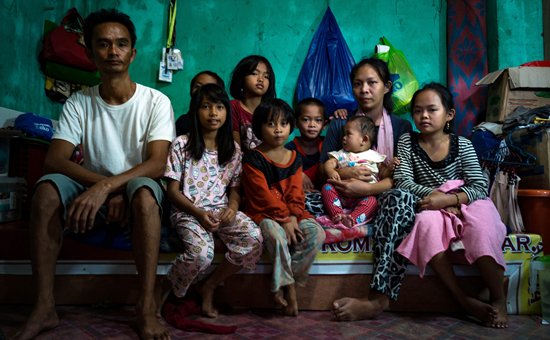
Diane
Sumangan, her husband and their seven children have been in
Saguiaran evacuation center for a year. She says life in the
evacuation center is difficult. They are patiently waiting
for government’s advice on where they should go next.
(ICRC
/ R. Hashempour) |
Marawi conflict:
One year on, longing and uncertainty for displaced families
By
ICRC
May 23, 2018
MANILA – Around
230,000 people remain displaced and in need of stronger support one
year after armed conflict broke out in Marawi City, Lanao del Sur,
southern Philippines.
“Efforts to rehabilitate
Marawi and assist its people must be stepped up to reduce the
suffering of thousands of those who were displaced over the past
year. The efforts are there, but these must match the growing needs
of those who face prolonged displacement and are close to despair,”
said Pascal Porchet, head of the International Committee of the Red
Cross (ICRC) delegation in the Philippines.
With the response shifting
from emergency phase towards early recovery, food donations have
dwindled and livelihood opportunities are reaching only a few.
Majority of displaced families still depend on relatives or friends
for support, while those in evacuation sites continue to struggle
with poor living conditions in makeshift camps, increasing their
risk of illness.
“It has been a year since
the armed clashes began and we still don’t know what lies ahead. I’m
starting to feel the weight of it, and there are times when I feel
like giving up. But for the sake of my children, I strive to stay
strong,” said Diane Sumangan, an evacuee in Saguiaran. She is a
resident of Bubonga Marawi, one of the 24 villages in the main area
affected by the clashes.
The displaced families,
added Porchet, struggle to feed their families, buy medicines or
resume their small businesses due to lack of livelihood
opportunities or capital. Uncertainty about the future has added to
their worries.
Authorities estimate that
65,000 residents from the main area where structures were reduced to
rubble will be unable to return home for the next two to three
years. The transitional site in Sagonsongan, Marawi City, can only
accommodate 6,000 of them.
“The ICRC remains
committed to supporting those who fled the fighting, and to do more
by addressing gaps in the overall early recovery response, in
coordination with the authorities and other aid organizations,”
Porchet said.
“But, it is primarily the
authorities’ role to assist people affected by conflict. The pending
issues concerning the transitional site such as lack of regular
supply of water and absence of proper sewage collection and
treatment should be resolved soon,” he stressed.
Particularly concerned
about the pain of people whose loved ones went missing during the
fighting, the ICRC and Philippine Red Cross (PRC) are following up
on the cases of more than 100 families with the aim of tracing the
whereabouts of their missing kin.
“We are stepping up
efforts to accompany and support these families. There is a need for
a neutral and independent organization such as the Red Cross to work
in this field. We encourage those with information about missing
people in Marawi to approach the Red Cross,” said Adriana Uribe
Villa, who leads the ICRC’s response in Marawi.
The ICRC has been
supporting the Management of the Dead and Missing Cluster since the
start of the crisis for the retrieval, management and identification
of human remains.
Ever since clashes broke
out in May 2017, the ICRC together with the PRC has been helping
thousands of people affected by the Marawi crisis. It is now
focusing its efforts to help the remaining displaced families in
Marawi and in Lanao del Sur by improving their access to health care
and clean water and by supporting their livelihood recovery efforts.
“We plan to direct our
assistance to certain high-security areas of Lanao del Sur, where
the ICRC has access thanks to its links established with the
community and non-state armed groups,” said Uribe Villa.
The ICRC is a neutral,
impartial and independent humanitarian organization whose
exclusively humanitarian mission is to protect the lives and dignity
of victims of armed conflict and other situations of violence and to
provide them with assistance. It has an international mandate to
promote knowledge for and respect of international humanitarian law.
Highlights of the
2016 List of Establishments (LE)
By
PSA-8
March 14, 2018
TACLOBAN CITY –
About 27,834 operating establishments in Eastern Visayas were listed
in the 2016 List of Establishments (LE). The region accounted for
3.0 percent of the country’s total number of establishments.
Eastern Visayas ranked
fifth among the regions with low number of establishments.
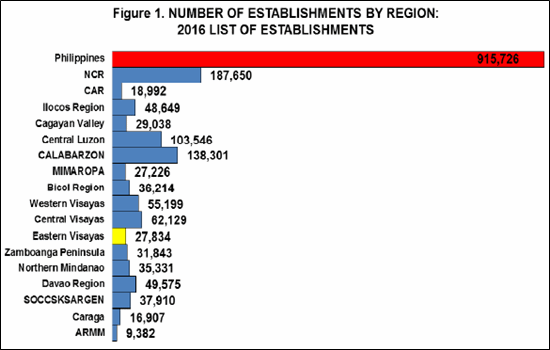
By province, Leyte
recorded the highest number of establishments at 14,598 which
accounted for more than half (52.4%) of the total establishments in
the region. Western Samar ranked second highest with 3,646
establishments or 13.1% of the region’s total number of
establishments. Northern Samar ranked third highest with 3,521
establishments or 12.6% share to the total number of establishments
in the region. Southern Leyte contributed 10.0% with 2,784
establishments. Eastern Samar shared 8.4% with 2,336 establishments.
Biliran, meanwhile, recorded the least number of establishments at
949 accounting for 3.4%.
By Section
Almost half (49.9%) or
13,883 establishments in the region were engaged in Wholesale and
Retail Trade; Repair of Motor Vehicles and Motorcycles (Section G).
Next in rank in terms of the number of establishments was
Manufacturing (Section C) contributing 14.8% or 4,120
establishments, and on the third rank was Accommodation and Food
Service Activities (Section I) with 3,189 establishments or 11.5% of
the total establishments in the region. With less than 50
establishments, Mining and Quarrying (Section B) and Water Supply;
Sewerage, Waste Management and Remediation Activities (Section E)
had the least with only 29 and 39 establishments, respectively, or
0.1% share each of the total number of establishments in 2016.
In terms of major industry
grouping: there were 341 establishments engaged in Agriculture
(Section A); 4,326 were engaged in Industry (Sections B to F); and
23,167 were engaged in Services (Sections G to S). These imply that,
for every 100 establishments, about 83 were engaged in Services, 16
were engaged in Industry and only 1 was engaged in Agriculture.
By Legal Organization
Majority (87.6%) or 24,392
establishments in 2016 were owned by single proprietors. Stock
Corporations reached 2,431 establishments or 8.7% of the total
establishments in the region. Cooperative accounted for 1.5% or 417
establishments, while Non-Stock, Non-Profit Corporation had 1.4% or
379 establishments. The rest of the establishments were categorized
as follows: Partnership (0.4%); Government Corporation (0.3%); and
Others (0.1%).
By Economic Organization
About 8 in every 10
(80.7%) establishments in the region were classified as ‘single
establishment’ in 2016. The number of branches listed was 4,202
which accounted for 15.1% of the total number of establishments. On
the other hand, only 22 or 0.1% were classified as ‘main office
only’, 967 or 3.5% were classified as ‘establishment and main office
in the same address’. The remaining 174 or 0.6% were classified as
‘ancillary units’.
By Employment Grouping
By employment grouping,
medium (with employment of 100 to 199) and large establishments
(with employment of 200 and over) combined comprised less than 1.0%
of the total number of establishments in the region. Majority
(93.0%) or 25,878 establishments were classified as micro (with
employment of 1 to 9). Small establishments (with employment of 10
to 99) reached 1,871 or 6.7% of the total establishments.
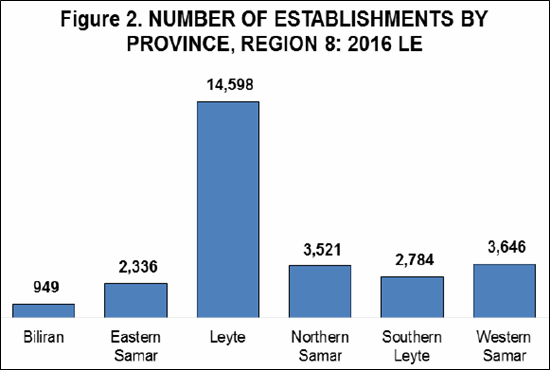
Total Employment
In 2016, a total of
134,476 employees were employed by the operating establishments in
Eastern Visayas. The region accounted for 1.7% of the total
employment in the country.
Eastern Visayas ranked
sixth among the regions with low number of employees.
By province, Leyte
recorded the highest employment at 80,126 which accounted for more
than half (59.6%) of the total employment in the region. Western
Samar ranked second highest with 16,878 employees or 12.6% of the
region’s total employment. Southern Leyte ranked third highest with
12,352 employees or 9.2% share to the total employment of the
region. Northern Samar contributed 9.1% with 12,243 employees.
Eastern Samar shared 6.8% with 9,179 employees. Biliran, meanwhile,
recorded the least employment at 3,698 accounting for 2.7%.
Employment by Section
In 2016, Wholesale and
Retail Trade; Repair of Motor Vehicles and Motorcycles (Section G)
surpassed other sectors with generated employment of 53,438, almost
two-fifths (39.7%) of the total employment in the region.
The Manufacturing (Section
C) ranked second which employed 19,511 persons or 14.5% of the total
employment in the region. Third in rank was Accommodation and Food
Service Activities (Section I) with 13,589 work force or 10.1% share
to the total employment in 2016.
The least contributor was
Mining and Quarrying (Section B) which generated 276 employment or
only 0.2% of the total regional employment.
By major industry, a total
of 102,371 persons were employed by the Services sectors which
comprised 76.1% of the recorded total employment in the region. The
Industry sectors employed 27,100 persons or 20.1% of the total
employment. The lowest was the employment generated by the
Agriculture sector with only 5,005 employees or 3.7% of the total
employment.
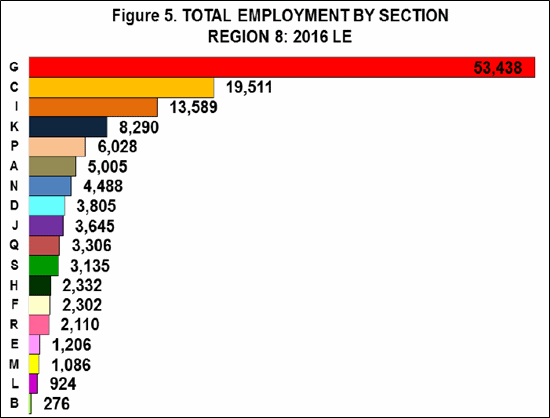
Average Employment per Establishment
The Average Employment per
Establishment in the region was recorded at 5 employees per
establishment.
By province, Leyte and
Western Samar recorded the highest Average Employment per
Establishment at 5 employees per establishment. Biliran, Eastern
Samar, and Southern Leyte followed with an average employment of 4
employees per establishment. Northern Samar, meanwhile, recorded the
lowest at 3 employees per establishment.
Average Employment per Establishment by Section
The three sections with
the biggest average employment per establishment were: Electricity,
Gas, Steam, and Air Conditioning Supply (Section D) with an average
of 67 employees per establishment; Water Supply; Sewerage, Waste
Management and Remediation Activities (Section E) with an average of
31 employees per establishment and; Construction (Section F) with an
average of 28 employees per establishment.
On the other hand,
Professional, Scientific and Technical Activities (Section M); Arts,
Entertainment, and Recreation (Section R) and; Other Service
Activities (Section S) recorded the lowest average employment per
establishment at 3 employees per establishment.
In terms of major industry
grouping, Agriculture sector had the highest average employees per
establishment at 15 employees per establishment. The Industry and
Services sectors had 6 and 4 average employees per establishments,
respectively.
◄◄home
I
next►►